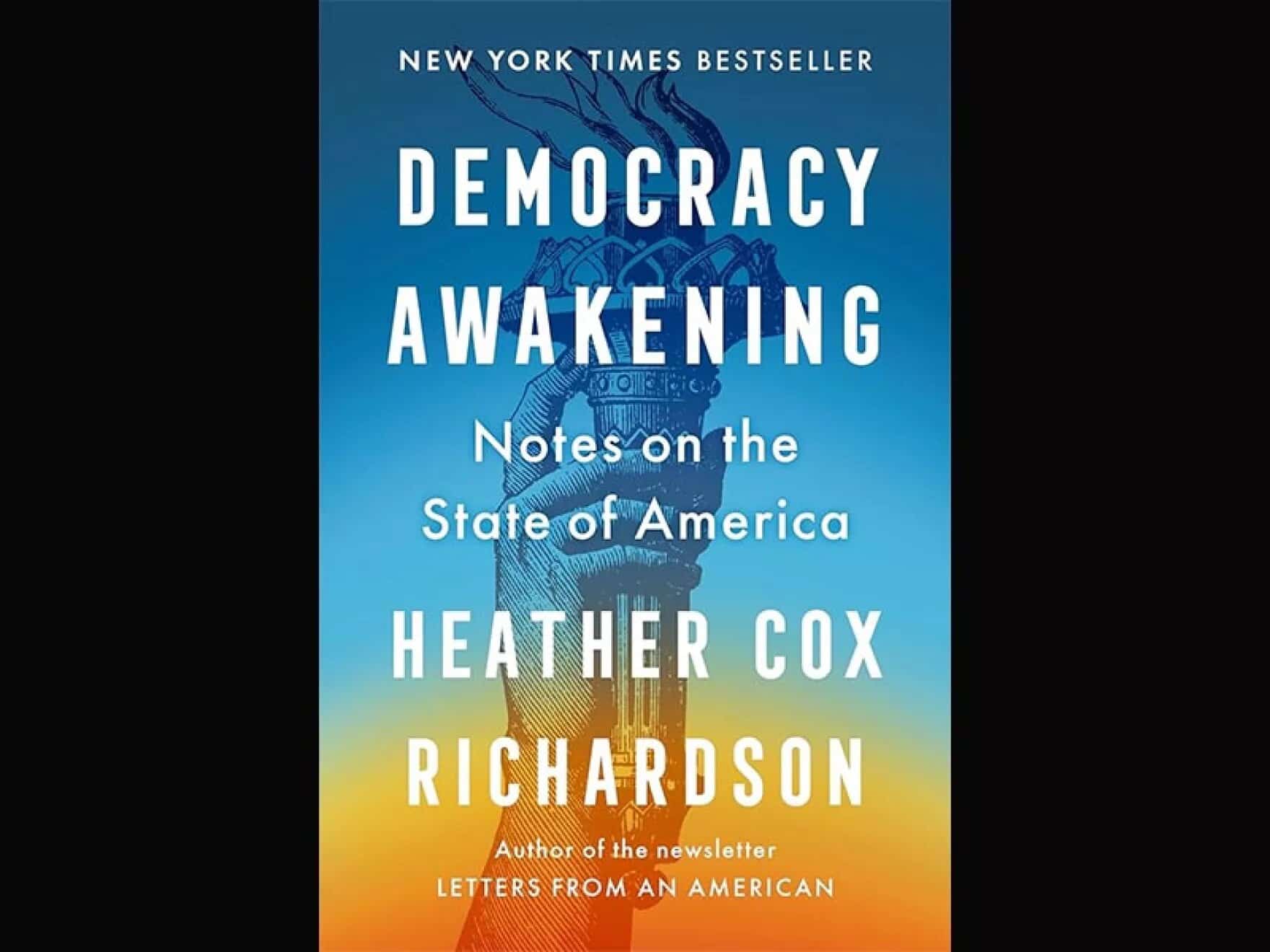“Republicans tied equality before the law to the principles of the Founders. They emphasized the danger of giving up democracy to an elite that based its power on a white supremacist reading of U.S. history.” If these lines give you a bit of whiplash, they should, but renowned historian Heather Cox Richardson is not wrong. The Republican Party began in a struggle for democracy against the interests of the rich, the powerful, and the racist. Her book, Democracy Awakening: Notes on the State of America, tells the story of democracy in America — of both the machinations of elites who used the state to increase their wealth and power at the expense of everyone else, and of the democratic and egalitarian movements who sought to expand civil rights and economic benefits to all. In this respect, it offers a celebration of the Republican Party of the 1860s and 1870s as well as the tragic story of how the party turned, first towards elite interests at the end of the 19th century before embracing the politics of white supremacy beginning in the mid-20th.
In the United States, a book about democracy is inherently also a book about race because anti-Blackness has been one of the defining ideological features of American democracy. Richardson leans into this dynamic, explaining the transformation of the Republican Party from one concerned with political and economic equality for Black and white Americans (as it waged a war of Indigenous genocide) into one stoking racism and white supremacy to cling to power. For Richardson, this evolution of the GOP is among the central causes of the current crisis, one in which the party is poised to nominate a twice-impeached insurrectionist and serial fraudster for another presidential term. She argues that “the Southern Strategy marked the switch over the parties’ positions over the issue of race,” one that would “provide a weapon for a certain kind of politician to rise to power” (39).
As President Lyndon Johnson observed, “if you can convince the lowest white man he’s better than the best colored man, he won’t notice you’re picking his pocket. Hell, give him somebody to look down on, and he’ll empty his pockets for you” (39). The eerie words of Johnson conjure images of a sea of adoring white faces wearing Trump paraphernalia as the former president spews Nazi-era slogans about immigrants “poisoning the blood of our country.” Not that the Nazi imagery is anything new for this “America First” movement, its oblique references to a “Lügenpresse” disseminating “fake news,” or indeed its embrace of the symbols and tactics of the putsch.
Richardson’s analysis is written in broad strokes and accessible prose that, while not meant exclusively for scholars, is one I believe carries deep scholarly value, even as she offers a synthesis grounded in the politics of the present. The book is organized into three sections — “Undermining Democracy, “The Authoritarian Experiment,” and “Reclaiming America” — which tell an interlocking story about how our history led to the Trump presidency and how historical movements have countered and defeated the white supremacist politics embraced by today’s GOP. Thinking about how our past is embedded in the present, as the book does explicitly in “The Authoritarian Experiment” section covering the Trump presidency, is both important for us as civic beings and raises important issues for scholars on the scope and impact of our analyses.
Those interested in the history of white supremacy and its relationship to the state, as my readers often are, will not be disappointed. While the first section, “Undermining Democracy,” is devoted to this form of elite capture — using the language of equality to describe a system of oppression — the dynamics of white backlash are present throughout as a response to the struggles and demands of marginalized, racialized, and dispossessed people. Especially striking, however, is Richardson’s analysis of the historical criminality of white conservatives. This was a defining feature of Reconstruction and Jim Crow, although Richardson I think wisely spends more time on the backlashes of the civil rights era, as a significant portion of her intended audience holds some nostalgia for this period of racial suppression. She recounts the story of Isaac Woodward, for example, a Black WWII veteran beaten and intentionally blinded by South Carolina police Chief Lynwood Shull for the serious crime of wearing his military uniform on a bus (17-18). A federal jury in Colombia, South Carolina later cleared Shull of the assault charges, but the attack on Woodward went on to inspire Black activists and led a horrified President Truman to issue Executive Order 9981 desegregating the military.
From the murder of Emmett Till in response to the 1954 Brown ruling to the assassination of voting rights organizers James Chaney, Michael Schwerner, and Andrew Goodman, Richardson shows time and again a white conservatism that readily turns to violence to serve their vision of “law and order.” Where she might have placed greater emphasis, however, is on the often collaborative relationship between white vigilantes, police, and courts. For example, the white men who murdered Till, Roy Bryant and J.W. Milam, had their charges dismissed by an all-white jury after Tallahatchie County Sheriff H.C. Strider publicly expressed doubt about the murder. Bryant and Milam then turned around and sold their confession to Look Magazine, in which they explained that they killed Till because they had decided that “it was time a few people got put on notice” because Black Americans “ain’t gonna vote where I live” and “they ain’t gonna go to school with my kids.” The Chaney, Schwerner, and Goodman murders were part of a killing spree of voting rights workers in Mississippi coordinated by members of the Klan and local police and headed by Baptist minister Edgar Ray Killen, all of whom went uncharged by local prosecutors.
It is hard to read these passages — especially with an understanding of the close historical relationship between white vigilantes and public officials — and miss the ideological connections between police and vigilante attacks on Black Lives Matter protesters as well as the recent mass shooters motivated by the Great Replacement Conspiracy Theory promoted by prominent Republicans.
One of the most striking elements of the book for me was Richardson’s account of the Trump presidency. While I was a close observer of and often wrote about the erosion of norms, attacks on institutions, and embrace of white supremacist ideas and fascist slogans of the Trump administration, I nonetheless found reading a careful account of these spanning the duration of his term to be devastating. Richardson’s analysis of the malice and criminality of the Trump years was made all the more powerful by her assessment of the malevolence and crimes of his Republican predecessors. Nixon’s race-baiting 1968 “law and order” campaign comes to mind, alongside of course his involvement in the Watergate scandal and his sabotage of the Paris Peace talks in 1968 that would have ended the Vietnam War (42-48). Ronald Reagan’s decision to launch his 1980 presidential campaign celebrating “states’ rights” in Neshoba County, where Chaney, Schwerner, and Goodman were murdered, deserves mention, especially if we recall that their killers were never indicted by local or state officials, but only in federal court. Worth mentioning, too, was the Reagan administration’s involvement in a massive drug smuggling and gun-running operation, the Iran-Contra Affair, bringing cocaine into the U.S. just as Reagan was accelerating Nixon’s “war on drugs,” who created the original campaign to target his political opponents (52-56, 63-65). Quite literally, Reagan and his cabinet — pardoned by Reagan’s vice president George H.W. Bush — were among the most successful drug smugglers in U.S. history.
Keeping this history in mind makes it much easier to make sense of a Trump administration that openly sought foreign interference in the 2016 election (102-105), gave policy priority to white nationalist figures and ideas (97-99), celebrated his party’s tacit embrace of white vigilantes and militia groups (111-116), used the office for personal profit and political gain (117-125), and attempted to overturn democracy and the 2020 election itself (131-40, 149-154). At the heart of this effort, in Richardson’s thinking, is history. The stories we tell ourselves are integral to how we apply power, a fact not lost on historical fascists. Trump is no different, claiming that his opponents — cast as un-American — “hate our history, they hate our values, and they hate everything we prize as Americans” (141). We see this in the broader Republican effort to suppress and whitewash American education and to mandate teaching “that America is a great Country” where schools “inspire patriotism and stop teaching the revisionist history of the radical left; our kids will learn about the wisdom of the US Constitution, the Bill of Rights, and the
founding fathers.” Historically, this sort of nationalist education provided the rationale in the U.S. for the state to support slavery, segregation, lynching, and anti-immigrant policies. It is no wonder that an aspiring authoritarian desires it.
One of the consistent themes running through the book is the idea that the rule of law is central to the project of democracy. Richardson draws on famous examples from the civil rights era to illustrate the claim. There can be no democracy if white conservatives can target and eliminate their opponents and both subordinate and plunder racialized groups without restraint. Indeed, this is the overarching lesson of Reconstruction, that democracy cannot prevail in the face of unprosecuted elite criminality and violence.
As someone who spends a great deal of time thinking about legalized systems of racial, class, and gendered violence in the U.S., and especially the impact of letting the organizers of coups, insurrections, and mass violence go unpunished, I worry a great deal about the inability and even unwillingness to hold Trump and his co-conspirators accountable. This failure led to the sabotage and collapse of multiracial democracy in the 1870s during Reconstruction, which began a nearly century-long apartheid state in Jim Crow. The refusal to prosecute the organizers of dozens of white supremacist massacres and thousands of lynchings between Reconstruction and the civil rights movement of the 1960s only worsened systems of violence and oppression. Likewise, the examples from the Nixon and Reagan administrations, insulated by presidential pardons, which were similarly employed by Trump for close aides, have only emboldened a right-wing minority that has consistently shown a willingness to use violence and fraud to retain power. What good could possibly come of refusing — as our country has historically — to hold these criminals and fraudsters accountable? What good has ever come of it?
Richardson’s work is as much about the contradictions of our shared past as it is an urgent call to action around the current authoritarian crisis threatening American democracy. From the outset she notes that, while American revolutionaries largely limited their vision of equality to propertied white men — those without property didn’t have widespread access to the vote until the 1820s — “people in the U.S. had never lost sight of the promise of democracy because marginalized people had kept it in the forefront of the national experience” (xiv). This tension between agitation for democracy and the forces of repression and white supremacist violence is a defining feature of the book and represents a cause for celebration for Richardson. We have a rich history that is genuinely deserving of praise in the U.S. without whitewashing and mythologizing the agents of white supremacy and oppression.
Although there is some overlap with the first section, the final third of the book is devoted to this historical movement for democracy. Richardson includes many participants in this struggle who are now (or should be) household names—Phillis Wheatley, Frederick Douglass, Abraham Lincoln, Virginia Minor, Wong Kim Ark, Ida B. Wells, W.E.B. Du Bois, Franklin D. Roosevelt, John Lewis, and Dr. Martin Luther King, Jr. In her thinking, these organizers and visionaries worked to build a country grounded in the premise from the Declaration of Independence that “all [people] are created equal” (163-169). Though incomplete and sabotaged by white elites, the victories of Black activists that led to the passage of the 14th and 15th Amendments were genuine victories worthy of our celebration in Richardson’s thinking. Over a century of struggle, this egalitarian vision won its fullest expression yet in Lyndon Johnson’s “Great Society” programs that expanded medical, resource, and education access, creating a “prosperity [that] was shared by white and nonwhite people more fully than ever before” (242). These programs, however, inspired the race-baiting “welfare queen” rhetoric of the Reagan campaign, which worked diligently to defund and dismantle the social safety net.
Organizers, agitators, and visionaries for civil rights and equality did, as Richardson suggests, often frame their work around the Declaration. On this point, I am always reminded of the Black Panther Party, who ended their founding Ten-Point Program with a passage from the Declaration. Their vision of equality was fundamentally material, and declared in the final, summary point, that “we want land, bread, housing, education, clothing, justice and peace.” This material articulation of equality was no mere wordplay. The Black Panther Party created one of the largest mutual aid programs in history based on their understanding of the needs of Black, marginalized, and dispossessed communities in American cities. They created free medical clinics and ambulance services, a free breakfast program for children, and grocery giveaways as well as childcare and education services.
While we often remember the Panthers as violent — and indeed they did advocate for armed self-defense and “an immediate end to police brutality and murder of Black people” — their aid programs identified and supplemented areas where the state refused to provide services to marginalized and impoverished communities. This point was not lost on J. Edgar Hoover, who waged a war of misinformation, sabotage, assassination, and elimination against the party. He wrote the F.B.I. agent in charge of the San Francisco office that the Panther’s aid programs had to be destroyed because “in their Breakfast for Children Program… they are actively soliciting and receiving support from uninformed whites and moderate blacks.” Nothing made the Panthers more dangerous, in his thinking, than actually providing aid to poor, racialized, and working class communities.
Thinking about these liberation and white backlash movements historically and dialectically, as Richardson’s work promotes, reveals the tenuous nature of the gains we have made as a society towards equality and genuine liberation. White elites can destroy these advances. They often have. It also emphasizes a key theme in her work — the role of white mythology in the legalized crimes of America’s predator class. This is a key takeaway of the book for me, both as a scholar of these white supremacist movements and as an agitator working to defeat them. There can be no justice, stability, or peace without accountability.






